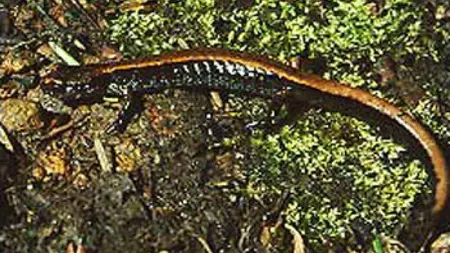
Order Caudata: Salamanders
Ambystomatidae: Mole Salamanders
Ambystoma gracile, Northwestern Salamander. In and near ponds and slow streams. West of Cascasdes.
Ambystoma macrodactylum, Long-toed Salamander. In many habitats, usually near water. Throughout state.
Ambystoma mavortium, Western Tiger Salamander. Larvae in ponds or lakes (occasionally neotenic), adults may be far from permanent water in steppe. East of Cascades.
Dicamptodontidae: Giant Salamanders
Dicamptodon copei, Cope's Giant Salamander. Larvae in streams, only rarely undergo metamorphosis in nature. Olympic Peninsula and south and west of Puget Sound.
Dicamptodon tenebrosus, Pacific Giant Salamander. In or near streams or mountain lakes. West of Cascades (but not on Olympic Peninsula).
Rhyacotritonidae: Torrent Salamanders
Rhyacotriton cascadae, Cascade Torrent Salamander. In streams. South Cascades.
Rhyacotriton kezeri, Columbia Torrent Salamander. In streams. Coast Range south of Chehalis River.
Rhyacotriton olympicus, Olympic Torrent Salamander. In streams. Olympic Peninsula.
Salamandridae: Newts
Taricha granulosa, Rough-skinned Newt. In and near ponds. From east slope of Cascades to coast, including islands.
Plethodontidae: Lungless Salamanders
Ensatina eschscholtzii, Ensatina. In forest. Throughout west of Cascades.
Plethodon dunni, Dunn's Salamander. In forest near water. Southwest corner of state.
Plethodon larselli, Larch Mountain Salamander. Mossy talus slopes in forest. South Cascades.
Plethodon vandykei, Van Dyke's Salamander. Rocky or mossy areas near streams and seeps. Olympic Peninsula and local south of Puget Sound in and west of Cascades.
Plethodon vehiculum, Western Red-backed Salamander. In conifer forest. Throughout west of Cascades.
Order Anura: Frogs
Leiopelmatidae: Tail-wagging Frogs
Ascaphus montanus, Rocky Mountain Tailed Frog. In mountain streams. Blue Mountains.
Ascaphus truei, Pacific Tailed Frog. In mountain streams. Olympics, Cascades, Willapa Hills.
Scaphiopodidae: North American Spadefoots
Spea intermontana, Great Basin Spadefoot. Steppe and shrub-steppe, breeding in temporary pools. East of Cascades south of Columbia River.
Bufonidae: True Toads
Anaxyrus boreas, Western Toad. Many habitats, usually near water. Throughout state except lower elevations of Columbia basin. Declining.
Anaxyrus woodhousii, Woodhouse's Toad. Riparian, steppe and shrub-steppe. Lower Columbia and Snake rivers, along south-central border of state and north of Blue Mountains.
Hylidae: Treefrogs
Pseudacris regilla, Pacific Treefrog. Almost ubiquitous, especially near water. Throughout state.
Ranidae: True Frogs
Rana aurora, Northern Red-legged Frog. Near or in ponds, especially in forest. West of Cascades.
Rana cascadae, Cascades Frog. In ponds and streams. Cascades and Olympics, above 600 m.
Rana luteiventris, Columbia Spotted Frog. In ponds and streams. Widespread in wooded habitats east of Cascade crest.
Rana pretiosa, Oregon Spotted Frog. In ponds and streams. Formerly widespread west of Cascades, now restricted to one population in central Thurston County, another in northwestern Klickitat County.
Lithobates catesbeianus, Bullfrog. In ponds and lakes. Introduced widely throughout lowlands of state.
Lithobates clamitans, Green Frog. In ponds and lakes. Introduced in Whatcom, King and Stevens counties (persisting?).
Lithobates pipiens, Northern Leopard Frog. In ponds. Lower Columbia and Snake river basins, isolated populations in Okanogan and Spokane counties; perhaps some populations introduced; declining.
Compiled by Dennis R. Paulson. Taxonomy and names updated December 2013 by DRP from Scientific and Standard English Names of Amphibians and Reptiles of North America north of Mexico, with comments regarding confidence in our understanding, seventh edition, Committee on Standard English and Scientific Names, Brian I. Crother, ed., 2012. Distribution information from Dvornich, K. M., K. R. McAllister, and K. B. Aubry. 1997. Amphibians and reptiles of Washington State: Location data and predicted distributions. Volume 2 in Washington State Gap Analysis - Final Report, (K. M. Cassidy, C. E. Grue, M. R. Smith and K. M. Dvornich, eds.), Washington Cooperative Fish and Wildlife Research Unit, University of Washington, Seattle.